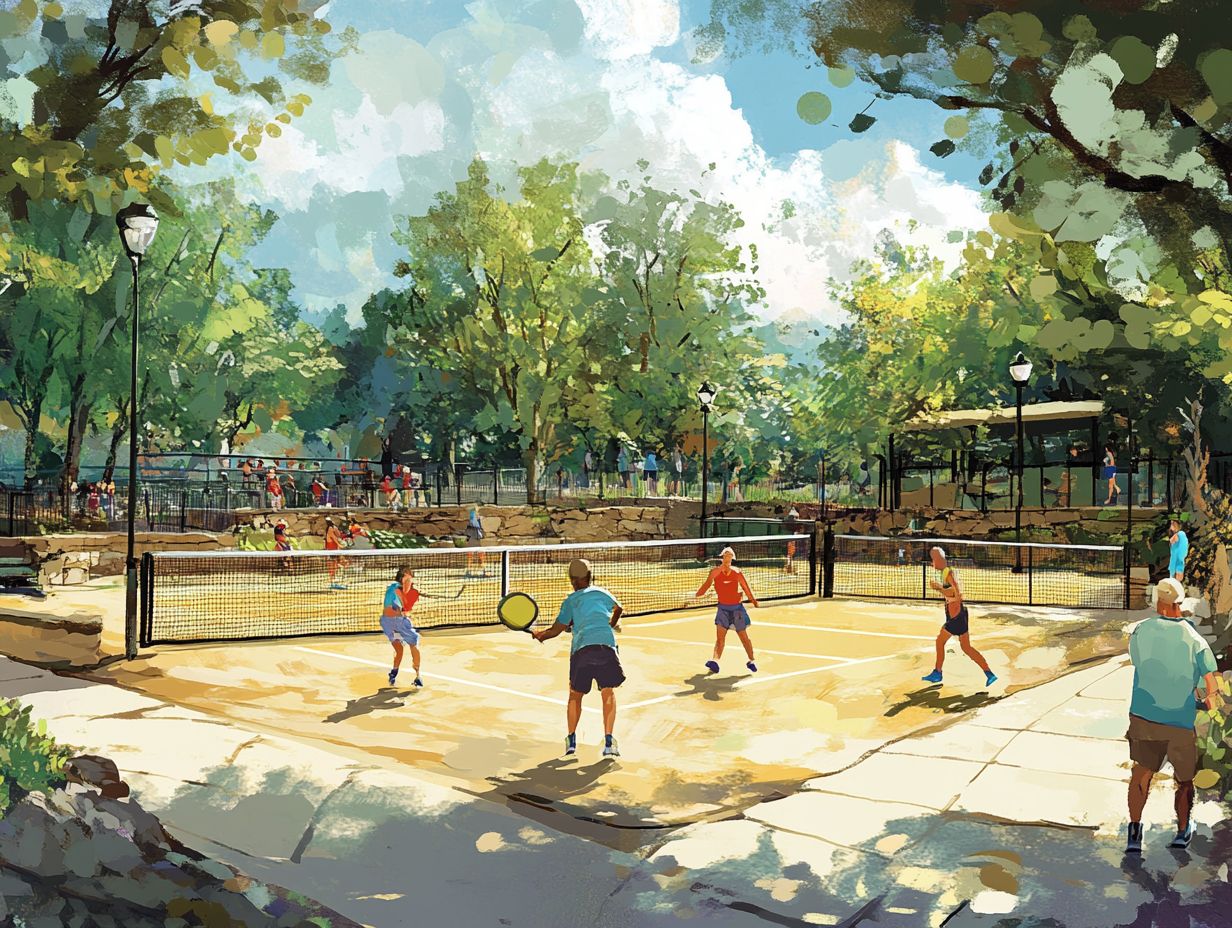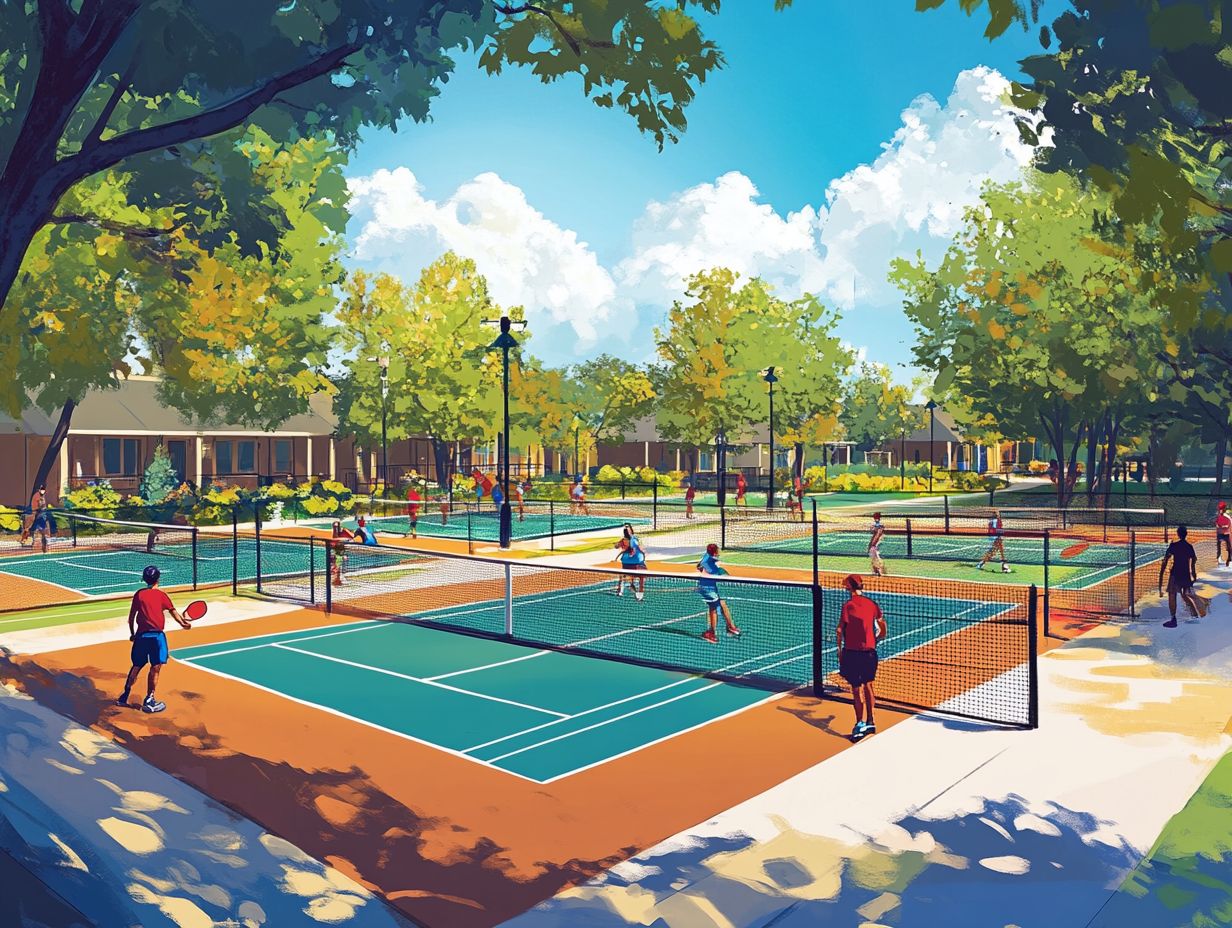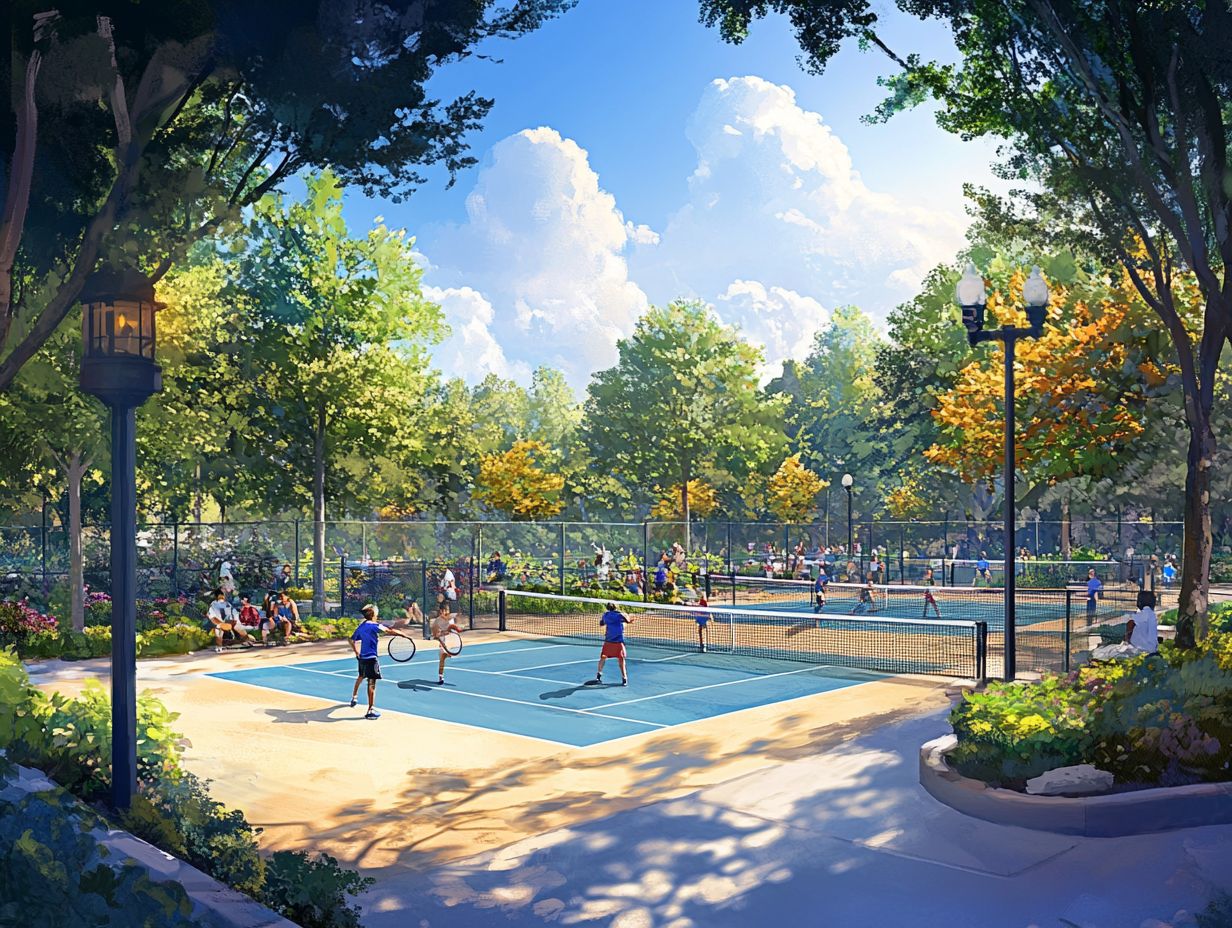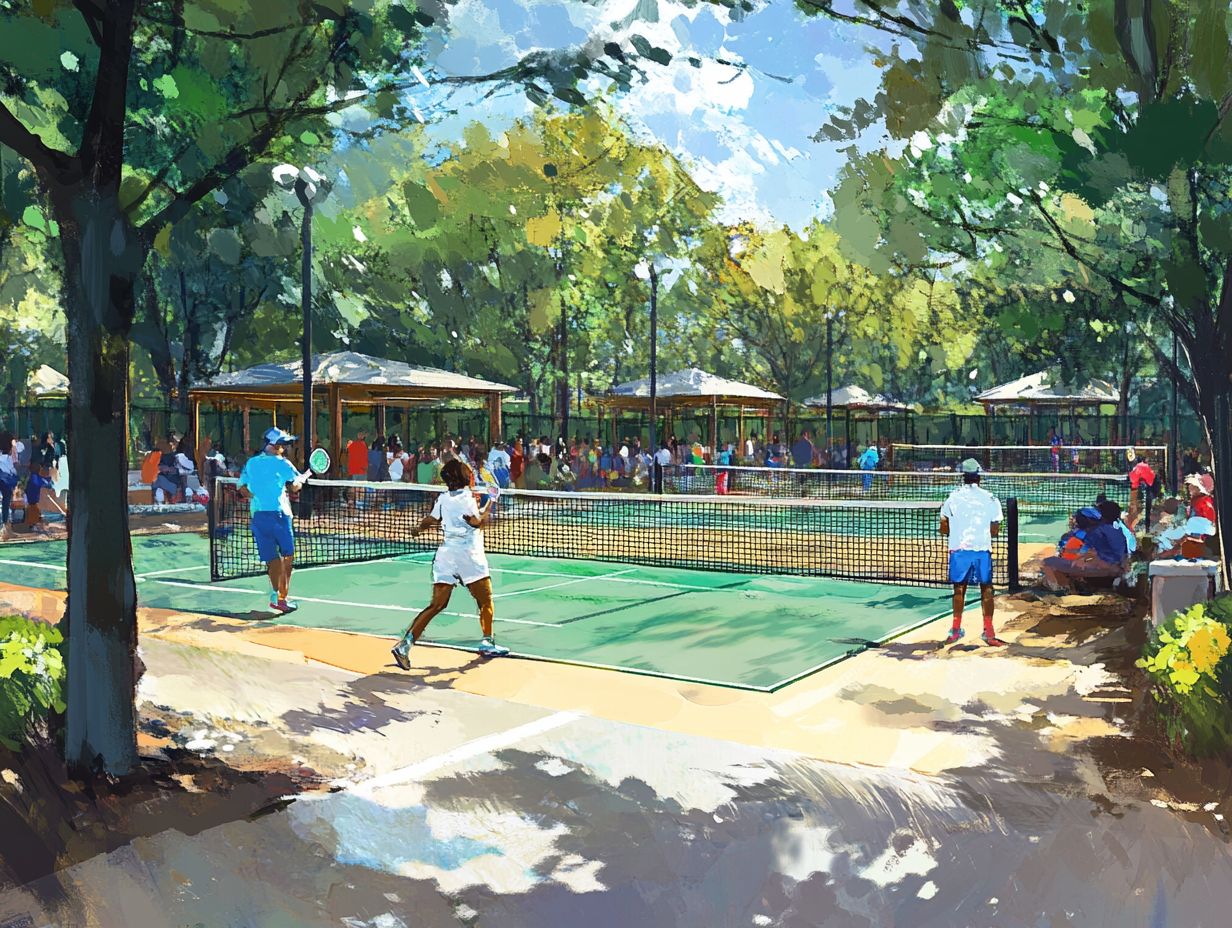Pickleball has taken the sporting world by storm, rapidly establishing itself as America’s fastest-growing pastime. Originally conceived as a casual family game, it has evolved into a competitive sport enjoyed by people of all ages.
This article explores the journey of pickleball, tracing its humble beginnings to its skyrocketing popularity and the numerous physical and mental health benefits it offers.
Additionally, it provides guidance on how to get started and connect with fellow players, while also looking ahead to the future of this dynamic sport. Whether you are a seasoned player or a curious newcomer, there is something here for everyone!
What is Pickleball?

Pickleball is a rapidly growing sport that blends elements of tennis, badminton, and table tennis, making it accessible and enjoyable for players of all ages and skill levels.
Originating in the United States in the mid-1960s, this engaging paddle sport has experienced a remarkable surge in popularity across America, particularly among families and at community centers.
The game is played on a court similar to that of badminton, with specific dimensions, and it can be enjoyed in both singles and doubles formats, making it a versatile recreational activity.
Origin and Evolution of the Sport
Pickleball was invented in 1965 on Bainbridge Island, Washington, by Joel Pritchard, Bill Bell, and Barney McCallum. What began as a family pastime evolved into a recognized sport, complete with associations and organized tournaments, such as those run by USA Pickleball, in the decades that followed.
The sport gained traction as regional and national associations formed, standardizing the rules and promoting competitive play. A pivotal moment in its evolution occurred in the 1980s when pickleball was introduced to schools and community centers, fostering a grassroots movement that attracted players of all ages.
Local clubs emerged across the country, organizing leagues and social events that helped cultivate a strong sense of community. By the 2000s, pickleball’s popularity surged even further, with both recreational players and serious competitors embracing the sport, ultimately establishing it as a vital part of the recreational sports landscape.
The Popularity of Pickleball
The rapid rise of pickleball as a popular recreational activity in America is evident in the fact that participation in the sport has increased by 158% over the past decade. This growth has made pickleball one of the fastest-growing sports in the United States, attracting players from a wide range of demographics, including children, working-age men and women, and seniors.
Growth and Participation Statistics

Participation in pickleball has surged in recent years, with millions of players engaging in the sport at various levels, including local clubs and recreational facilities across the country.
Recent statistics from the Sports & Fitness Industry Association indicate that pickleball has experienced an impressive annual growth rate of 20 percent in player numbers. This growth has been particularly notable among younger players, as schools have started incorporating pickleball into their physical education curriculums.
The emergence of dedicated pickleball clubs has fostered a community and competitive atmosphere that attracts both experienced and novice players. Additionally, the expansion of recreational facilities featuring pickleball courts has made the game more accessible, creating an inclusive environment for participants of all ages and skill levels.
Benefits of Playing Pickleball
Playing pickleball offers numerous benefits, including enhanced health and wellness through cardiovascular exercise, increased social interaction among players of all ages, and reduced risk of injury due to its low-impact nature.
These advantages make it an ideal sport for maintaining an active lifestyle throughout one’s life.
Physical and Mental Health Benefits
Pickleball offers numerous physical fitness benefits, including improved cardiovascular health, enhanced endurance, and increased flexibility, along with mental health advantages such as social interaction and stress relief.
This unique combination of tennis, badminton, and table tennis provides a comprehensive workout for those looking to stay active. Regular players often experience improved endurance, resulting in higher energy levels throughout their day.
The fast-paced nature of pickleball engages a variety of muscle groups, contributing to overall strength and coordination. Additionally, the social aspect of the sport is significant, as players forge friendships and connections through friendly competition. This sense of community can help alleviate feelings of anxiety and depression.
How to Get Started with Pickleball

The accessibility of pickleball, along with its sport-specific training programs, makes it an excellent choice for beginners. This sport requires minimal equipment, and its straightforward rules allow new players to quickly learn the game and enjoy it.
Additionally, beginners can benefit from training programs and coaching available at local pickleball clubs.
Equipment and Rules of the Game
Pickleball requires specific equipment, including paddles and balls, and understanding the court dimensions and game rules is essential for effective play and enjoyment.
Players should select a paddle that aligns with their style of play, as there are various options available made from different materials such as wood, composite, or graphite. Each material offers unique benefits in terms of weight and grip.
The balls used in pickleball are made of plastic and feature holes that allow for proper airflow, ensuring a suitable bounce on the court.
A standard pickleball court measures 20 feet wide by 44 feet long, accommodating both singles and doubles play. Players must also navigate specific areas, including the non-volley zone, commonly referred to as “the kitchen.”
Familiarizing oneself with the basic rules, including scoring systems and faults, will enhance the overall experience and ensure that every match is competitive and enjoyable.
The Community of Pickleball
The pickleball community comprises numerous clubs and organizations that engage players through tournaments, social activities, and community events, creating a welcoming environment for individuals from all walks of life.
Connecting with Players and Tournaments

Local competitions and tournaments offer an excellent way for pickleball players to connect with one another. These events provide players with the opportunity to sharpen their skills, enjoy camaraderie with fellow enthusiasts, and engage with audience members who share a passion for the sport.
Competitions serve as a significant platform for athletes to showcase their abilities and cultivate relationships that extend beyond the game. Well-organized events not only create a competitive atmosphere but also facilitate networking opportunities, allowing players to bond over common interests and shared successes.
Additionally, audience engagement is vital, as it fosters a lively environment that transforms each match into an unforgettable experience. Watching skilled players can inspire and motivate both newcomers and seasoned players to refine their techniques, ultimately contributing to a more connected and thriving pickleball community.
The Future of Pickleball
The future of pickleball looks promising, as industry expansion and increased media coverage are generating greater interest in the sport. This growth is attracting sponsorship opportunities and the establishment of professional leagues, which will enhance its visibility and accessibility for players of all skill levels.
Predictions and Potential Challenges
While predictions for the growth of pickleball are optimistic, several challenges must be addressed to ensure the sport’s ongoing popularity and expansion. These challenges include maintaining community engagement, ensuring accessibility, and securing regulatory support from pickleball associations.
The sport has started to attract players from diverse backgrounds and varying skill levels, making it essential to engage local communities to build strong player bases and enhance experiences. One of the most significant challenges is providing enough facilities to accommodate the influx of new enthusiasts. Collaborating with local governments and schools can facilitate the construction of additional courts.
Furthermore, developing adaptive programs for seniors and individuals with disabilities is another way to attract new players. Through sustained efforts toward accessibility and inclusivity, pickleball can not only expand but also cultivate a vibrant community around the sport.

Pickleball’s more than a game to me—it’s a passion. I write, sharing its highs and lows, the thrills and the lessons. Some tales might draw you to the court, while others give a hint of the game’s magic. So, curious about my journey? Ready to dive deep into the world of pickleball with me? Let’s go.
